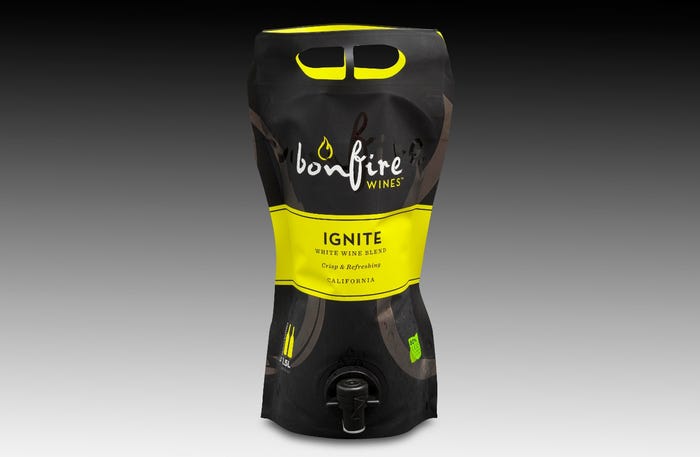August 26, 2014

The Bonfire Wines shaped pouch is easy to hold, as well as being a lightweight alternative to the typical glass wine bottle—for considerable weight savings during shipping.
In recent years, food and beverage manufacturers have been placing increasing emphasis on reducing the packaging weight for the benefits of promoting environmental sustainability and reducing costs throughout the supply chain. This practice is known as “lightweighting.”
Conventionally, a package is “lightweighted” in one of two ways:
First, the package material itself can be replaced with a lighter weight alternative. For example, Bonfire Wines, which packages its wine in pouches rather than bottles, has an 80% smaller carbon footprint and stores two times the total wine in one package.
Alternatively, the package material itself can be cut. The water bottles produced by Sidel Rightweight for Water offers a weight savings of 34% versus a conventional commercial bottle, with the use of its Rightweight technology.
Despite the popularity of the practice, lightweighting can be the wrong approach if it results in a package that has compromised the consumer’s experience.
Packaging efficiency model
Instead of focusing on lightweighting, the designers should look toward a model that PwC describes as “packaging efficiency.” According to this model, packaging efficiency can be defined as a more holistic approach that covers the entire lifecyle of a package. It considers five specific areas:
1. The resources used in its creation;
2. Its ability to protect the product;
3. Transport and display efficiency;
4. Its ability to provide a positive customer experience;
5. Its impact at end of life.
If we take the two examples singled out earlier—the Bonfire Wines pouch and the Sidel Rightweight bottle—we can see that as well as being lightweight, they are also efficient. While the model of packaging efficiency does not indicate major compromises, there have been significant gains in the areas of transport, resource consumption and display efficiency, including the ability to transport more packs in the same truck, display more packs on shelf and a design that always faces the consumer on the shelf or in the fridge.
Another example of an efficient solution, this time from the flexible packaging sector is Ella’s Kitchen. It has transformed the baby food market with a flexible pouch that is not only attractive but, by being squeezable, is also useful to a busy parent on the go. This is both an efficient and lightweight outcome.
However, in other cases, the use of flexible packaging can be an inefficient solution, if it compromises the consumer experience. For example, using a lightweight design for larger microwavable products like ambient soups, make the package unstable and can result in the customers burning themselves.
Additionally, some packages, like pouches, present challenges in terms of recycling, particularly when compared to other formats, such as PET containers.
We know from experience that consumers simply will not buy packaging that makes their lives harder. This year, the industry is facing a difficult balancing act—reducing our environmental impact, without harming the consumer experience. The good news, however, is that by adopting more balanced approaches, such as the packaging efficiency model, it’s possible to lower the environmental impact of our packaging, while at the same time creating products that make our customers happier.
That is a positive outcome for the health of our planet, our industry and our customers.
Ian Lifshitz is the sustainability director for the Americas for Asia Pulp & Paper Group (APP). He is responsible for leading the company's sustainability and related stakeholder engagement programs across Canada, the United States, and South America. Lifshitz is also charged with leading the company's North American CSR activities, translating and communicating many of APP's successful conservation, biodiversity and social community programs to North American audiences.
About the Author(s)
You May Also Like




